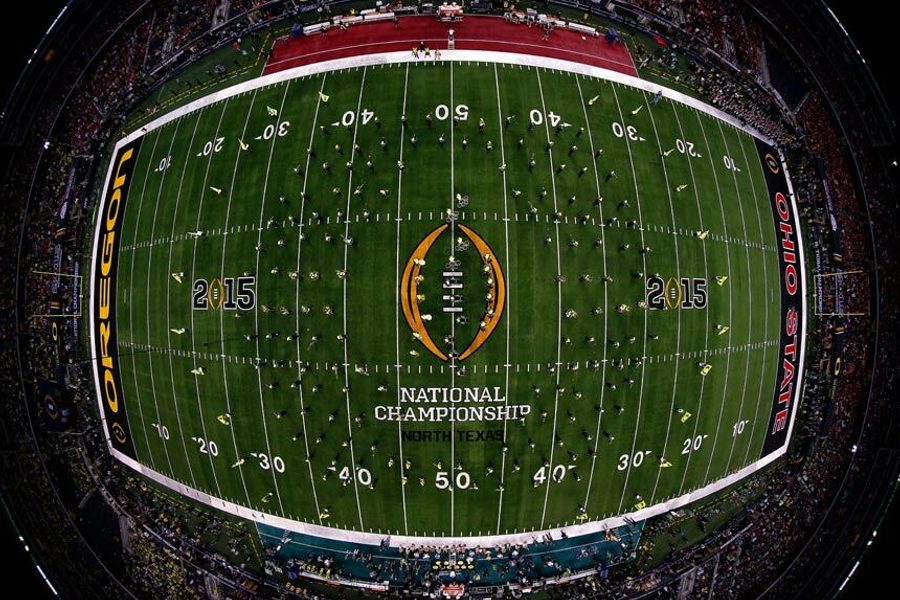At Colleges, Running Backs Get All the Greenbacks, While Academic Students Fight Over Crumbs
College football has become a bloated, multi-million dollar business, subverting the original mission of universities—education.
Gilbert M. Gaul

The following is an excerpt from Gilbert M. Gaul’s Billion-Dollar Ball: A Journey Through the Big-Money Culture of College Football, published on August 25.
In 2012, college football generated a remarkable $103 million for the University of Texas athletic department, with $78 million falling to the bottom line. Note that the money didn’t go to the university itself. As at many other elite football powers, the Texas athletic department was nominally part of the university but in reality functioned as an autonomous business. It was overseen by a CEO/coach, Mack Brown, who received millions more than the university president. His nine full-time assistant coaches averaged $555,000, or about four times what a full professor earned.
In the view of most Texans, this was acceptable — as opposed to, say, a distortion of the university’s primary mission of education. It was perfectly okay that the Texas football budget had grown 20 times faster than inflation over the last three decades. Or that Texas spent $261,728 on each of its football players, but just $20,903 on each student. Big was what Texas did best. Texas football was the very definition.
With the vast wealth the largest and richest schools accumulate from television deals, tickets and seat donations, they can probably afford to be overly generous. But there are only 60 or so schools that fit this description. The 60-plus other schools that play Division I football don’t have the luxury of these income streams. Most operate on a shoestring and lose millions of dollars each season. In the last decade, though, pay for head football coaches at these schools (Ohio University, Florida Atlantic, Western Kentucky, Toledo, Eastern Michigan, among others) has doubled, up to $1 million.
“A lot of these schools can’t afford it, but they do it anyway because they want to compete at a higher level, and in order to get there they think they have to pay their coaches like the larger schools,” said Jeff Smith, an instructor of accounting and finance at the University of South Carolina Upstate.
Athletic arms race
Near the end of 2013, I flew to Eugene to tour the Football Performance Center at the University of Oregon. It was underwritten by Nike co-founder Phil Knight at a cost of nearly $70 million and is far and away the most lavish building in America devoted solely to college football players — biometric key codes for the players to come and go, climate-controlled lockers and Brazilian ipe hardwood flooring in the weight room. I didn’t know what Brazilian ipe hardwood was until Craig Pintens brought me up to speed.
“Brazilian ipe is the densest wood in the world,” the senior associate athletic director for marketing and public relations explained. “And it won’t catch on fire. As you know, there is a problem with weight rooms catching on fire.”
“Actually, I didn’t know that,” I said.
“It happens a lot, apparently.”
For the most part, Oregon’s Football Performance Center reminded me of an upscale shopping mall. Each time we turned a corner, we came upon another expensive bauble or design: a players’ lounge with PlayStations and two custom-made foosball games imported from Portugal; a barbershop for quick prepractice trims; floor-to-ceiling glass walls and marble flooring imported from Italy; and so on. This was the athletic arms race on steroids.
One of the best ways to understand what a university values is to see how it treats its most ambitious undergraduates. I decided to visit the Robert D. Clark Honors College, which serves approximately 1,000 of the University of Oregon’s brightest students.
Several professors and administrators all told me the same story: The honors college was one of the university’s greatest assets, underappreciated, and short of cash.
Chapman Hall, home to Clark Honors College, was considered state of the art in 1939. There are no interior staircases to reach the second and third floors. One of the two classrooms is called Fireside, though the fireplace hasn’t worked in years.
Despite its outdated accommodations, students continue to apply to Clark in record numbers.
“Our students can hold their own,” Renée V. Dorjahn, director of finance and administration, proudly informed me. “We have many Fulbright scholars. … Last year we had three Goldwaters. Stanford only had two.”
A large percentage of Clark students qualify for academic scholarships, and some even receive full tuition. But Clark students are charged higher tuition— about $3,000 more — than other students, under the assumption they are receiving a more challenging and costly education. So if you netted the $3,000 from the $5,000 grant that typical Clark students receive, Oregon’s smartest students received a $2,000 scholarship in real terms. Two thousand dollars is certainly better than no dollars, but it pales next to a $50,000 football scholarship.
“We met with the athletic director. We were very blunt,” Bill Harbaugh, an economics professor at Oregon, told me. “We said, give us 1 percent of your budget. … You can buy us off real cheap. So we said, how about a ticket surcharge? They didn’t like that idea at all. ”
Congressional Kabuki
At its core, college football is an extension of a series of concepts that give it structure: Players are student athletes, not professionals; mandatory payments to secure premium seats are charitable gifts, not fees; the market for lavishly paid coaches is, in fact, a market. But what happens if that structure collapses — if, say, some ambitious member of Congress actually questions the football-as-charity paradigm?
In July 2014, Sen. Jay Rockefeller (D-W.V.) held a hearing that was largely an opportunity for senators to lob verbal grenades at the NCAA and its president, Mark Emmert. In that respect it was like most congressional hearings: carefully staged Kabuki theater. Nevertheless, Rockefeller did say one interesting thing: “Playing college sports is supposed to be an avocation. There’s a growing perception that college athletics, particularly Division I football and basketball, are not avocations at all. What they really are is highly profitable enterprises.”
He continued: “This country is now so soaked in the culture of ESPN … it’s undermining our values. I’ll tell you one thing for sure: I think it’s undermining our commitment to education.”





